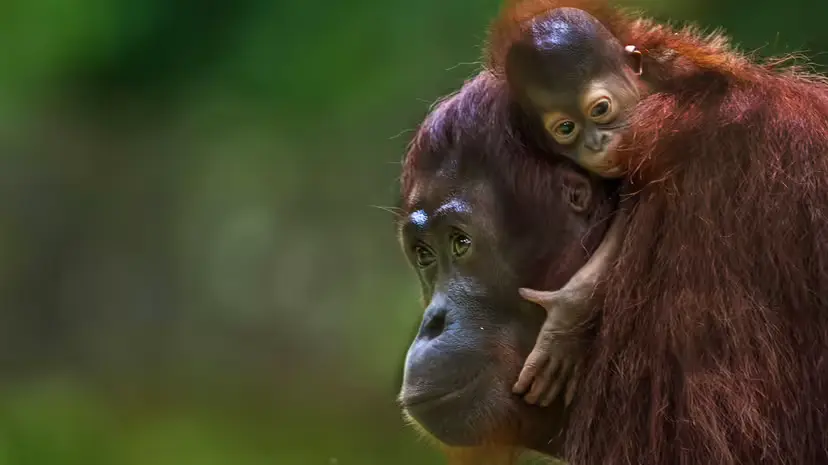Status: Critically Endangered; most recent estimates put the wild population under ~14,000 and declining.
Why they’re disappearing: Rapid deforestation (especially for palm oil and timber), habitat fragmentation, illegal trade, and occasional hunting.
What’s working: Protected areas, confiscation and rehabilitation of ex-pets, anti-poaching patrols, and market pressure for deforestation-free palm oil.
What’s needed next: Keep forests standing, reconnect isolated habitats with corridors, scale community-based protection, and strengthen law enforcement across the trade chain.
Often called “people of the forest,” Sumatran orangutans are among the most intelligent nonhuman primates. They live almost entirely in the trees of northern Sumatra’s tropical rainforests, spending their days foraging and their nights in leafy nests they build anew—sometimes two—every evening.

Size: Adult males stand ~1.4–1.8 m (4.5–6 ft) and typically weigh 50–90 kg (110–200 lb); females are smaller (~0.9–1.3 m; 30–50 kg).
Coat & build: Long, reddish-orange hair; exceptionally long arms (about 50% longer than their legs) for brachiation; hands and hand-like feet provide powerful grip and precision.
Brainy problem-solvers: Use sticks to extract insects or honey, fashion leaf “gloves” to handle spiny fruits, and memorize vast seasonal food maps.
Life history: Very slow reproduction—females give birth roughly once every 7–9 years, the longest interval of any mammal. This makes every adult female crucial to population recovery.
Historically widespread across Sumatra (and formerly parts of Java), Sumatran orangutans now persist mainly in Aceh and North Sumatra provinces. They inhabit lowland and hill rainforests, peat swamps, and montane forests—ecosystems that also store huge amounts of carbon and regulate regional water cycles.
Forest cover has fallen dramatically in recent decades due to oil-palm expansion, illegal logging, roads, and encroachment.
Remaining forests are increasingly fragmented “islands” separated by plantations and settlements.
Fragmentation reduces access to seasonal foods, increases inbreeding risk, and raises conflict and trade vulnerability along forest edges.
Palm oil is the dominant driver: clearing for plantations and related roads/canals opens the forest to further logging and fires.
Peatland drainage for agriculture causes subsidence and flammable conditions, leading to haze-forming fires that destroy habitat.
Infants are taken for the pet trade; obtaining a baby typically involves killing the mother.
Despite legal protection, low penalties, patchy enforcement, and demand make trafficking persist.
In some areas, opportunistic hunting for meat or perceived crop protection still occurs.
When forest foods are scarce, orangutans may raid fruit crops, provoking retaliation.
Roads and plantations funnel orangutans into human-dominated landscapes where they are easier to capture or harm.
National parks such as Leuser and Bukit Tigapuluh harbor key populations.
Confiscated orangutans are rehabilitated and reintroduced to suitable protected forests after medical checks and survival training.
Wildlife corridors and restoration plantings reconnect isolated forest patches, allowing gene flow and seasonal movement.
Anti-poaching patrols remove snares and monitor hot spots.
Stronger prosecution of traffickers and middlemen (not just field poachers) increases deterrence across the entire supply chain.
Conflict mitigation: crop-guarding teams, buffer crops less attractive to orangutans, and rapid response units.
Livelihoods: support for sustainable agroforestry, shade-grown coffee/cocoa, honey, spices, and conservation jobs (rangers, nursery work, monitoring).
Education & co-management: school programs, village agreements, and locally led forest stewardship.
Push for deforestation-free, peat-free, exploitation-free supply chains (NDPE).
Support high-integrity certification and landscape/jurisdictional initiatives that protect entire forest mosaics, not just plantation boundaries.
Nest counts and camera traps track population trends.
Genetics/eDNA clarify relatedness and connectivity.
Remote sensing flags new forest loss and fire risk, guiding patrols and restoration.
Buy deforestation-free: Choose brands with strong, transparent NDPE palm oil policies.
Support in-country NGOs: Fund reforestation, patrols, rescue centers, and community programs.
Travel responsibly: If visiting Sumatra, pick operators that follow strict wildlife-viewing guidelines and contribute to conservation.
Advocate: Ask retailers and policymakers to enforce import rules against commodities linked to forest loss.
Spread the word: Share science-based info; discourage keeping primates as pets—ever.
How do Sumatran orangutans communicate?
With a rich repertoire of vocalizations (including long calls that carry over a kilometer), facial expressions, and gestures. Tool use and object manipulation also convey information in social contexts.
What’s the single biggest threat?
Habitat loss and fragmentation, particularly from palm oil expansion and associated infrastructure. Without intact, connected forest, all other interventions struggle to keep pace.
Is palm oil always bad?
Palm oil yields more oil per hectare than most crops; the key is eliminating deforestation, peat drainage, and labor abuses. Demand strict supply-chain standards rather than simple boycotts that may shift pressure to other sensitive regions.
Why is population recovery so slow?
Females give birth only once every 7–9 years. Losing even a few adult females has outsized impact; protection must focus on keeping breeding females safe and their habitat intact.
Save the forest, and you save the orangutan—along with countless other species and vital climate and water services. The Sumatran orangutan’s future depends on connected, living rainforests, effective law enforcement, and communities that benefit from keeping trees standing. With consistent support and smarter supply chains, recovery is possible.
animal tags: sumatran orangutan
We created this article in conjunction with AI technology, then made sure it was fact-checked and edited by a Animals Top editor.